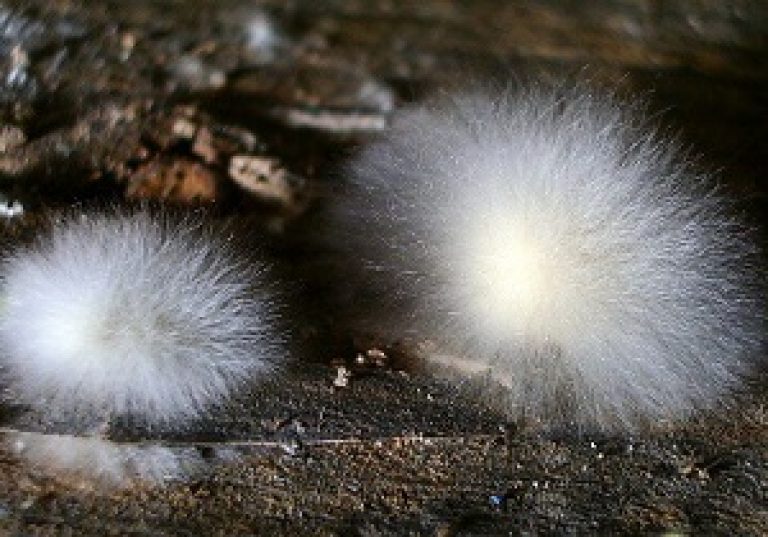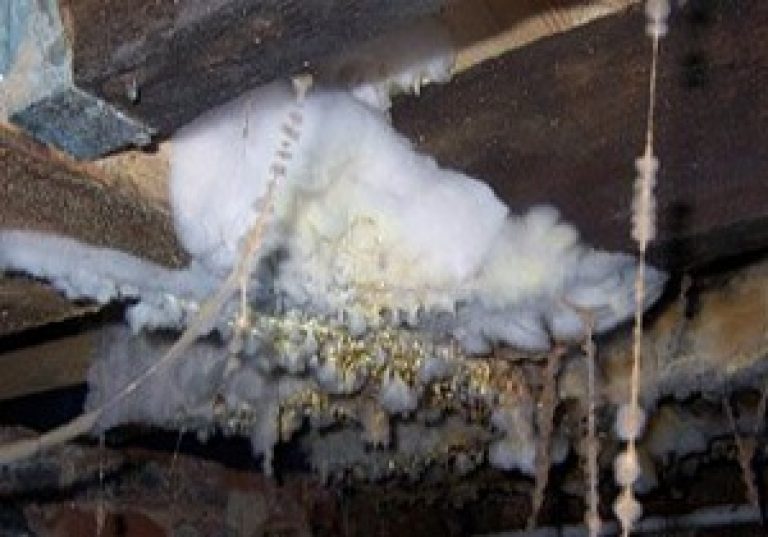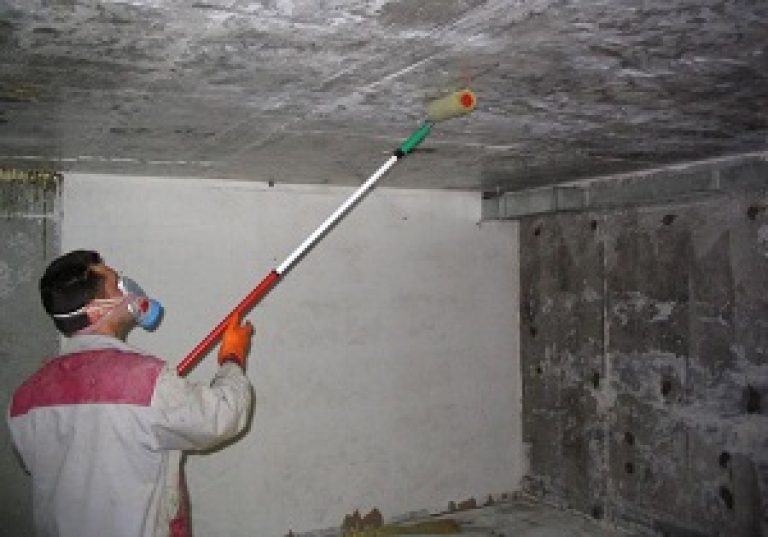Fungus or mold in the cellar, similar to cotton wool: how to get rid of it forever and clean the room
Mold in the cellar, similar to cotton wool, is very common. This is due to poor ventilation, high humidity. Many have ceased to pay attention to the mold in the cellar. Harmful stains on the ceiling not only spoil the appearance, but can also cause significant damage to human health.
In addition, products stored in the cellar will suffer. Mold has the ability to spread to other objects, actively multiply, which significantly reduces the shelf life and usefulness of products. If you find a fungus in the cellar, be sure to take care of the destruction of the mold. The following material will help to do it right, to prevent the reappearance of the fungus.
What is mold

Fungal colonies that develop from spores are called molds. Spores are constantly in the air, only under the influence of adverse factors (high humidity, heat) they begin to “wake up” and actively multiply. Molds can grow on concrete, paint, wood. There are many types of mold fungus, depending on this, you can see spots that look like cotton wool in black, brown, green, white. There are also luminous fungi, but they are not dangerous for the walls, ceiling of the cellar.
Mold is capable of destroying building and finishing material, sometimes it comes to the base. Therefore, the owners of mold in the cellar should think about getting rid of the colonies of fungi as soon as possible, otherwise they will have to make repairs or even rebuild. Allocate black, white, brown mold. The specific color depends not only on the type of fungus, but also on the stage of development, the color of the surface on which the uninvited "guest" settled.
Reasons for the appearance
Mold never appears just like that, this event is preceded by other adverse circumstances:
- absence or clogging of ventilation shafts. The lack of fresh air contributes to the growth of fungal colonies;
- increased level of air humidity, accumulation of condensate. This aspect often depends on the first factor;
- insufficient air circulation in the cellar;
- storage of rotten fruits and vegetables. Spoiled products become sources of mold, spores actively spread throughout the room, settling on walls, floors and ceilings;
- the use of wooden products that are infected with fungal spores.
Note! Depending on the growth of colonies of mushrooms similar to cotton wool, the methods of dealing with uninvited "residents" of the cellar also differ. Without eliminating the adverse factor, it is difficult to protect the health and integrity of the premises.
Favorable conditions for reproduction

Why does mold grow in some cellars and not in others? For the emergence of "life" certain conditions are necessary:
- the presence of spores in the air. They are transported and settle in the cellar on people, food, animals;
- nutrient organic medium (paper, wood, soil, peat pots);
- favorable microclimate (high humidity, temperature about 20 degrees). Poorly working or non-working ventilation also negatively affects.
Some types of fungus have the ability to reproduce at a temperature of 0 degrees.
Pay special attention to the ventilation system. After all, it is designed for normal air circulation in the room. Air movement prevents mold spores from attaching to any surface. In the corners, the movement of air is difficult, it is there that colonies of mushrooms often accumulate.
Ventilation helps to remove excess moisture from the room, which occurs against the background of high humidity outside or a large difference in temperature. If there are fungal spores on the walls, but there are no favorable conditions for reproduction, then they will not germinate. Based on this, we can conclude that poor ventilation is the main reason for the appearance of mushroom colonies in the cellar.
The danger of a fungus to humans
Many do not suspect that mold poses a huge danger to human health and even human life, not only for building materials. The affected ceiling, floor (especially wood) can cause serious injury. In most cases, mold affects human health in the following ways:
- through direct skin contact;
- human respiratory and circulatory system;
- consumption of food contaminated with fungi.
Spores of many types of mold are toxic, multiply very quickly (1 square meter of mold is capable of throwing over a billion spores into the air). In view of this, when it enters the human body, many ailments can develop.

The unpleasant consequences of contact with mold fungi are such pathologies:
- dermatological diseases occurring against the background of allergic reactions (mycosis);
- pathologies of the upper respiratory tract (nosebleeds, sinusitis, a severe runny nose, many patients note shortness of breath);
- dizziness, headaches;
- indigestion, digestive problems, bouts of nausea, vomiting;
- exhaustion of the body, anemia.
The long-term influence of mold on the human body leads to malfunctions in the functioning of the kidneys, liver, even internal bleeding occurs, sometimes emphysema. The risk group includes elderly patients, children, people with a weakened immune system, patients who have survived fungal infections are especially susceptible to lesions.
Note! Mold allergy can be diagnosed in many laboratories. If you find such a problem, urgently get rid of the causative agent of trouble.
Effective methods of struggle
How to treat the cellar from mold and fungus? Destroying mold is hard work that requires a lot of effort and time. It is necessary to take into account the causes of the trouble. An integrated approach will help get rid of mold, similar to cotton wool, and prevent the re-growth of fungal spores in the cellar. The fight against fungal colonies is carried out in several stages, each of which is described in detail below.
Preparing to Eliminate Dangerous Microorganisms

Helpful Hints:
- at the time of processing the premises, be sure to free it from all objects, fixtures and food. Thus, you will provide excellent access to possible mold localization sites, protect the products that are in the cellar;
- remove all furniture, large items from the room. They also need to be treated to avoid re-infection of the cellar with mold;
- carry out general cleaning in the room. Clean off all the mold, if the spores of the fungus have penetrated deep into the finishing material, be sure to replace the damaged structures with new ones;
- the tree rots very quickly, if the floor is earthen, then about 20 centimeters of the soil layer must be removed (it is probably infected);
- after careful processing of the cellar, proceed to dry the room. Only then is it allowed to proceed to the direct fight against mold.
Destruction of colonies of fungi
It is not enough just to remove visible mold, it is necessary to completely destroy dangerous microorganisms. In specialized stores, you can easily find antiseptics that show an antibacterial, disinfectant effect. Preparations must be used strictly for their intended purpose, adhering to the instructions.
How to deal with mold in the cellar? An excellent result is shown by folk remedies that quickly destroy dangerous microorganisms. Their use is very simple, rarely causes allergic reactions.
Folk recipes for fungus on the walls:
 What and how to get rid of at home? We have an answer!
What and how to get rid of at home? We have an answer!
What do bed bugs look like and how to treat bites of blood-sucking insects? Read the answer page.
Go to the address and read the information on how you can treat an apartment from fleas.
Precautionary measures
To avoid allergic reactions, damage to the skin, you can use the following precautions:
- put on a protective suit, goggles and gloves before starting the destruction of mold;
- it is strictly forbidden to smell, touch dangerous microorganisms;
- after processing the premises, leave it;
- products affected by mold are strictly prohibited to eat.
Only by clearing the cellar of pathogenic microorganisms, you will feel completely safe, eating fresh and healthy products.

Regularly carry out preventive measures to combat dangerous microorganisms in the cellar. Keep the room clean, clean regularly, be sure to thoroughly dry the room:
- drying of the cellar takes up to fourteen days. Carry out manipulations on cloudless days, take the shelves outside, pre-treat them with water and liquid soap;
- after a week, the boards are completely dry, then treat them with an antifungal agent;
- dry cellar, also after thorough drying, treat with a similar agent;
- if the cellar includes an earthen floor, then pour a solution of copper sulfate into it. Place sand or lime under the vegetables.
After such prevention, no mold will settle in the cellar, all products will be stored for a very long time. Follow useful tips, if microorganisms still multiply, then use the tips for destroying mold.
Another interesting method of fighting mold in the cellar and garage can be found in the following video:



